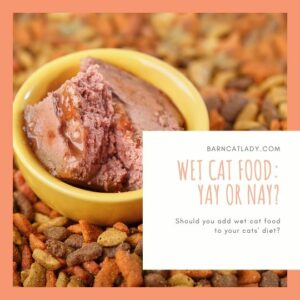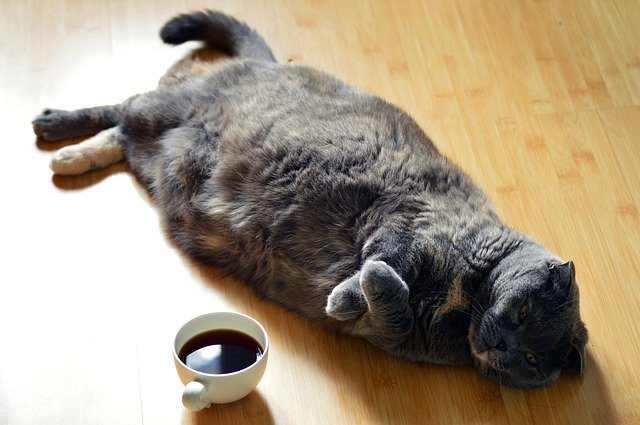
There’s a lot of misconceptions and confusion about cat food in general, but especially regarding wet cat food.
Dry food is good for their teeth, people say. Wet food has meat by-products, which are hooves and beaks and feathers, people say. A raw diet is best, some say. All store-brand food is crap, people say. Dry food is better for their teeth, people say.
All of that is myth and rumor, not based in fact at all. Just preference.
I’ll give it to you straight. As much as we know about cats, there is still much we do not know. Nothing is simple with regard to feline nutrition. There are many risk factors to cat obesity, diabetes, and more. Nutrition is only one side to that coin.
You can feed the best food in the world and still have a fat, unhealthy cat because he stays inside 24/7 and doesn’t get exercise, or because he’s genetically predisposed. And because he’s fat, he will likely develop diabetes and other health issues. You can ensure your cat gets enough moisture and he’ll still develop urinary blockages because of genetics.
And what’s great for one cat, might not be great for another. So do your research and decide what is best for your cat or cat colony!
It doesn’t help that cat food labels are very confusing to read as well. So let’s discuss wet cat food, and the pros and cons of adding it to your cats’ diets.
Disclaimer: I am not a veterinarian. This article is for educational purposes only and should not be used to diagnose or treat any illness or disease. Please discuss any health issues regarding your pets or cat colony with your veterinarian.
Benefits of Wet Food
There are actually quite a lot of benefits to adding wet cat food to your pet or community cat’s diets.
The number one benefit of wet food is hydration.
The number one reason to feed wet cat food in addition to (or instead of) dry food is hydration. The domestic feline evolved to obtain most of its moisture from their prey. That means their food. Cats naturally have a low thirst drive and many cats on a dry cat food diet may be mildly or moderately dehydrated.
Wet cat food contains around 65% or more of moisture, depending upon the brand. Dry food contains 10-20% moisture.
Even if you THINK your cat is drinking enough water, chances are he is not.
Dehydration in cats can have lead to several health issues, but the most important is the development of crystals in the urine or urinary blockages. Feeding a dry food only diet is often blamed for these urinary issues.
Cats naturally have more concentrated urine than dogs or humans do. Possibly because they evolved in a desert environment and needed to conserve moisture, but whatever the reason, cat urine is concentrated. Cats – especially male cats – are prone to urinary problems. A urinary blockage can be extremely painful and rapidly fatal to your cat.
If you want to make sure your cat is getting enough moisture, adding wet food to your cat’s diet will help!
Whatever brand you can afford, wet food is more actually more nutritious than dry food.
If you are feeding dozens of cats and can consistently afford only Friskies brand cat food, then the wet cat food Friskies is more nutritious than the dry Friskies.
Why is that? Because dry food is processed to within an inch of its life. It’s heated to dry it out. As most of you know, overcooked food has little to no nutritional value compared to fresh, uncooked foods.
So what they do is add vitamins and minerals to dry cat food to make it a complete and balanced diet. Yes, even ‘natural’ food has added vitamins and minerals to ensure it meets a cat’s nutritional needs.
Wet food is often higher in protein as well when you compare the same brand.
Wet food has fewer carbohydrates.

Cats on a dry food only diet are more prone to obesity and diabetes if the cat is confined indoors, according to some studies. This is likely because dry food has many more carbohydrates than cats need in their diets and the fact they don’t get enough exercise. However, a high-fat diet with no exercise would do the same.
Cats are obligate carnivores. They must have a diet consisting of meat, meat, and meat. The ONLY carbohydrates a cat in nature ingests is from the stomach contents of his prey. Our feline companions need little if any carbs in his diet. Dry foods have a lot more carbohydrates than a cat needs, no matter what brand you buy.
Why feed a cat a lot of carbohydrates when they wouldn’t eat that in nature? It’s because carbohydrates are cheaper than straight meat. It’s not harmful exactly, except it can cause weight gain, which itself is harmful. But it IS convenient and cost-effective. But this is a major reason why switching to wet cat food or adding wet cat food to your cat’s diet might be important to you.
Stay away from gravy varieties of wet food if you want to reduce carbohydrates and starches in your cat’s diet.
Wet food gets its protein from meat, not plants.
Wet cat food is often higher in protein than dry cat food, but what’s more important is that the protein source is from animals, NOT plants. Sadly, some protein in dry food comes from plants.
Cat food is only required to be labeled the minimum amount of crude protein contained in the meal, not what TYPE of protein.
Cats, unlike dogs and people, are obligate carnivores. Their entire digestive system is designed to eat meat. They do not get enough nutrients from plant-based sources because they don’t digest it well.
Wet food adds variety and flavors cats love!
I wouldn’t want to eat the same food all the time. That’s really boring. It’s boring for your cats too! Cats also enjoy new flavors. With wet food, you can buy a variety of flavors, textures, and brands.
Cats deserve to have the food they enjoy just as much as humans do.
Disadvantages of Wet Food
To be honest, there aren’t many. And it all comes down to convenience and price.
Wet food can be more expensive.

If you compare wet cat food meals vs. dry cat food meals, wet cat food is more expensive.
So if you can only afford to feed decent dry cat food, but would have to drop down to cheap wet food, I can understand the hesitation.
This is why you may want to consider simply adding a meal or two of wet cat food and leave the dry cat food out the rest of the time if your cat isn’t prone to obesity.
Wet food is not as convenient.
Feeding dry food is convenient. It stays fresher, longer. You can buy large bags. You can leave it out all day. There’s no danger it will go bad.
Cats naturally want to eat many small meals a day. Left to their own devices, they will hunt and eat anywhere from 7-20 meals a day! They don’t digest large meals as well. In fact, there was a study done on how changing meal frequency and adding a wet food diet increased voluntary physical activity in cats. Basically, cats fed wet food many many times a day will have more energy than cats that are fed dry food once or twice a day.
We can’t free-feed wet food. It goes bad. Hence, the popularity of dry food.
And if you fed wet food 9 times a day, chances are you’d be feeding WAY too much and cause your cat to get fat as well.
Wet Food: Myths
There are a couple of myths about feeding wet cat food I’d like to discuss.
Dry cat food is better for their teeth.
This is false. Dry cat food does absolutely NOTHING for their teeth. In order for dry cat food to be useful for dental health, it would need to allow the tooth to sink INTO the kibble.
Dry food shatters when bitten. It is not porous enough to let the tooth sink into the kibble.
Cat food kibble is also very small usually and not large enough to do this as well.
And any cat owner knows, cats do little if ANY chewing of their kibble. How do we know this? When they VOMIT dry food, it’s almost completely whole. This is because cats don’t have molars and are not designed to chew food. They are designed to swallow big chunks of meat whole.
So how on earth would it work to clean their teeth?
If you’re looking to help your cat’s teeth, there is NO substitution for dental care with daily brushing and veterinarian dental cleaning.
However, if you’re caring for feral cats or semi-feral cats, or just want to help your cat’s teeth, I suggest using special dental treats such as Greenies or chew-sticks made of silvervine. That said, any cat outside taking care of himself likely has better teeth than your pet cat does. It’s because they chew fur, hide, etc. which helps to keep their teeth clean, while house cats do not.

Is Dry Cat Food Bad for Your Cat?
No, not necessarily. There are some decent enough dry food out there if you want to spend the money. And it has its uses such as convenience and price. Especially if you’re feeding multiple cats or feeding feral cats. Or you have a day job that takes you away from the house for 12 hours, you can be sure your cat is eating properly while you’re gone.
But I do highly recommend adding wet food to at least one meal. No need to mix it with dry food, unless your cat likes it like that.
The cheapest cat food is better than starvation, for ferals or strays you feed.
Owning cats, especially adopting from shelters, is a wonderful life for most cats. Even on a dry food diet, it is much better than going unwanted on the street to die for lack of a home, just because you can’t afford premium cat food.
Wet Cat Food: Yay!
There is very little reason to NOT feed your cats wet food, at least in addition to dry food.
I definitely think you should find the best cat food you can afford, both dry and wet cat food, but don’t feel badly you can’t feed the strays or your pet the best food money can buy.
If you want a long, involved website regarding feline nutrition, wet vs. dry food, and the benefits of raw diets, I do suggest you visit catinfo.org. It was written by a veterinarian.
Do you add wet food to your cat’s diet? Tell me your favorite brand below!
Lovies!


I have had cats since I was very young. I used to live on a farm so we had a lot of barn cats. Some were tame, most were just ornery barn cats! I currently have two cats—a three year old female and a 7 week old female kitten. We just got the kitten so they are getting used to each other.
I have a few questions about feeding wet food and how to introduce it to a cat that has only had dry food.
So, how do I do this? Feed one can a day? Feed one can a week? I would like to add some wet food to my cat’s diet since I now know more about my cat than ever!
When should I start the kitten on wet food? She has been eating dry food since about 5 weeks old.
Thank you. I honestly learned more about cats in reading your article than I have known about them my whole life!
Hi! Thanks for the compliment!
I definitely recommend feeding wet food at least once a day. I wouldn’t feed an entire can at once, though. Unless it’s a small 3 oz can.
As for how to introduce your cat to wet food, honestly, that’s the easy part! Just put it on a plate, the smell will attract your furry companion and they usually munch down on it immediately. They LOVE it. And chances are, depending upon where you got the kitten, she has already had wet food after being weaned from mama.
Side note: some cats will not eat wet food. I have one that has NO interest in it at all. He went from a bottle, straight to dry CAT food. He wouldn’t even eat dry kitten food! To this day, he doesn’t like wet food at all.
Good luck with your kitties!
Hello and thanks for your wonderful post on feline feeding facts. Although it’s been 3 years since my last cat past away I do plan to get another one once my living situation has improved. I appreciate all of the advice you have provided here. It will be very helpful when I get another cat. I always bought high quality dry food for my cats. I gave them more wet food as the got older and started losing teeth. In the future I’ll make a point of providing a mixture depending on what the finicky feline might be inclined to at the time. Yes, I’m totally guilty of spoiling my cats and proud of it.
Regarding their dental health, a lady who owned a pet food store once told me to give the cats a raw chicken wing to chew on and this would help reduce tartar build up. Personally I never tried this. I was wondering if you may have heard of this option for feline dental health?
Cheers,
David
Hi, David! Thanks for visiting!
There’s definitely no shame in spoiling your cats!! I spoil mine daily.
Regarding the raw chicken wing thing. Overall, not a good idea. This isn’t about dental health, it’s about the fact raw chicken can carry bacteria and raw chicken bones are hollow. Raw chicken bones are DEFINITELY better than cooked, because cooked bones splinter, but all bird bones are quite fragile and can get stuck in their throats or cause injury to their digestive tract. It’s only a slight chance, but one I don’t want to take.
That said, giving a cat a chew toy designed for cats or silvervine sticks or even a jerky stick (unseasoned) would help their teeth, so a chicken wing would likely help clean their teeth. I just would rather use something safer.
Thanks again!